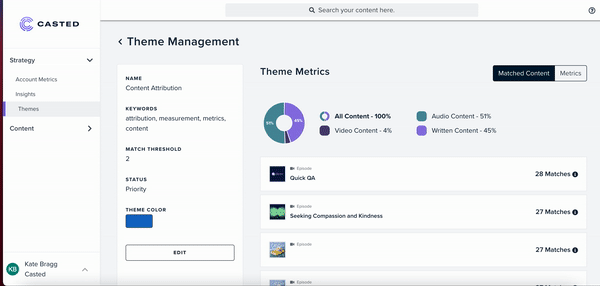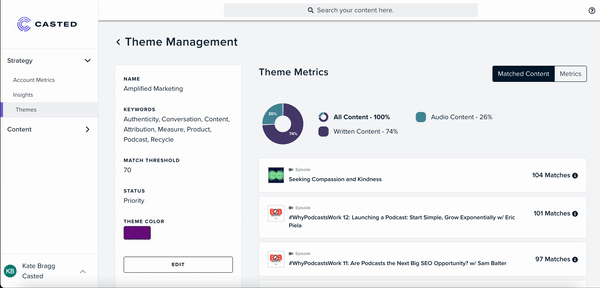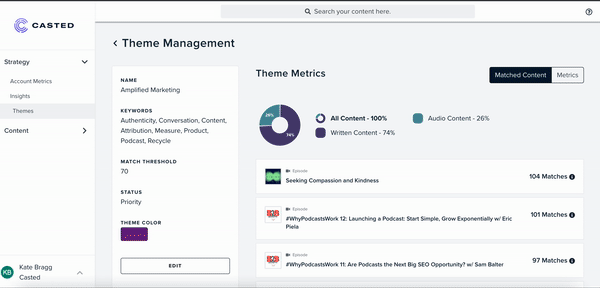Content planning. Some love it. Creatively, it can seem like the sky’s the limit. And that’s why so many content marketers love what they do.
But it can also be challenging to know what’s going to be successful. Especially if you’re not sure what resonates most with your audience. You know what you want your content to achieve, but you have to reverse engineer how to hit your goals. It can feel like a lot of guesswork — and brainstorming isn't much fun when every idea you throw out seems like a shot in the dark.
However, there is a new solution that makes it a lot easier and more effective for content marketers to create and execute a successful content plan — not a content guess. It’s called Themes. I’m Mark, the Content Marketing Manager at Casted, and I’m going to walk you through how I use Themes to help me and our team be a lot more strategic and insightful in our content planning, creation, and amplification.
Get a 360-Degree View of Your Existing Content
I’m looking ahead to the next quarter and planning out our content stream. I know about an upcoming product release, and I know what our messaging around this release should be.
What I don’t know is how much of this might already exist in the content our team has created over the last several quarters. I also don’t have a firm grasp of all the possible topics we haven’t discussed but are relevant to our messaging and release. I would be wise to have some of the blanks filled in before I call the team together to brainstorm.
In all my previous roles, the only way to get an idea about existing content was to head over to our content hub and go through every post, ebook, podcast episode, and webinar one by one and keep a list of what each piece covered. Sometimes I might be able to look at the keywords we tagged in the content, but that only gives me a general idea of coverage. If I’m really lucky, I might be able to look at some performance data. That should give me an idea about which content has resonated best with our audience.
Sometimes I might even be bright enough to create a content mapping spreadsheet where I list each content piece and what it covers. Then I can reverse engineer that list into a second list showing all the topics I recorded and which pieces of content they’re in.
After all that, I’m probably exhausted and start wondering what I thought I was trying to do in the first place.
But if I am using Themes in the Casted Amplified Marketing Platform, I just create a theme, and I get to see all the existing content — visualized by keyword-density, content type, and actionable insights.
 This is going to help me significantly determine the best ways to reuse or repurpose content, choose the best formats for new content that we’ll create, and then amplify our content across every single channel that our audience prefers.
This is going to help me significantly determine the best ways to reuse or repurpose content, choose the best formats for new content that we’ll create, and then amplify our content across every single channel that our audience prefers.
Identify Content Gaps
Now that I know what we’ve already got in our wheelhouse, I need to answer another important question: What is my audience interested in that we haven’t covered yet? Before that content calendar blooms to life, I need to know where the gaps are in our content, and the traditional way of doing that means looking through search data and determining what my audience is googling that we don’t have yet.
But that can be very time-consuming depending on your industry, and after you gather all this information on your own, you might not be doing anything more than guessing. Sure, you should be reading all the content and commentary you can on core topics and categories, because that might give you a more educated guess, but it still feels a little insufficient.
Themes makes this responsibility easier to accomplish with more effective insights. Not only can I see what I’m missing, but in cases where we’ve covered bordering topics, I can see how I can take sections from a variety of other content and immediately create a new piece of content.

How Themes Helps Content Marketers
That’s how I used to plan content. Here’s how it goes using Themes:
I schedule a kickoff meeting with the team to plan out the content calendar for the coming quarter. Among our regular content cadence, we also have a big product release coming up and some new messaging around that — and we want to make a big splash.
We start things off with a brainstorm to determine our theme for the quarter and spend some time identifying keywords that will be important for the product release. Then we pull up Casted.
We don’t have to dig through a hub or a spreadsheet. We just create a new quarterly theme. We enter the keywords, and the Casted platform finds every video, podcast episode, and blog we’ve already made featuring these keywords.
Next we look at this content list and determine what our best content is. We’ve already published a really successful podcast episode where one of our customers discusses how they’ve been using the beta of the new product. Our product team has already put together a live demo video as part of the launch, and we found a dozen related blog posts, two ebooks, and a good selection of webinars and videos to choose from.
Now we can take a look at the content we’ve identified with Themes, pull the relevant sections into a new document and create a couple new blog posts and videos that we can amplify on social media. This gives our team a massive headstart on next quarter’s content calendar.

Bottom Line
Using Themes kind of changes my life. For the first time as a content marketer, I can truly understand what content I have already created, how it’s performing, and the gaps I have yet to cover — and without manually digging through it piece by piece. There are a few other benefits too:
-
- My company can break out of costly content silos.
- My content marketing team can view content themes and assets together in one place.
- Using Themes, we can quickly uncover all the audio, video and written content buried away in our digital archives.
- We can then leverage actionable insights to develop engaging campaigns and create and amplify new content in every channel.
- And ultimately, this allows us to drive connections and conversions.
All I have to do is create a theme, and our technology collects all of the matching assets in our library, so the whole marketing team can see how our content works together and how our audience actually engages with it.
And with a 360-degree view of everything we've created, we can amplify our best audio and video conversations across blogs, social media, landing pages, and more using the tools in Casted Studio like transcription, key takeaways, and audio- and videograms.
For more on how amplified marketing can improve the lives of B2B marketers like you, check out the Amplified Marketing Playbook. Better yet, request a demo.


